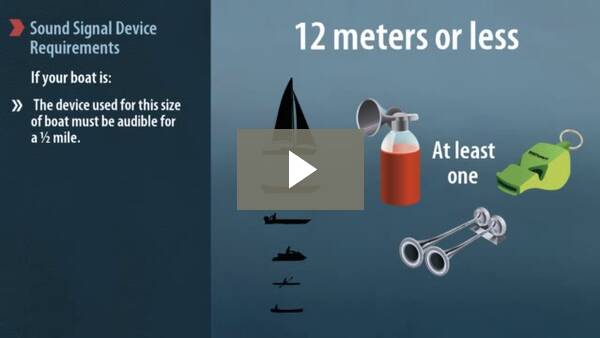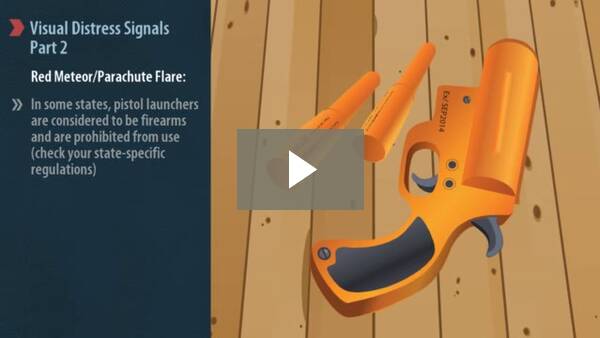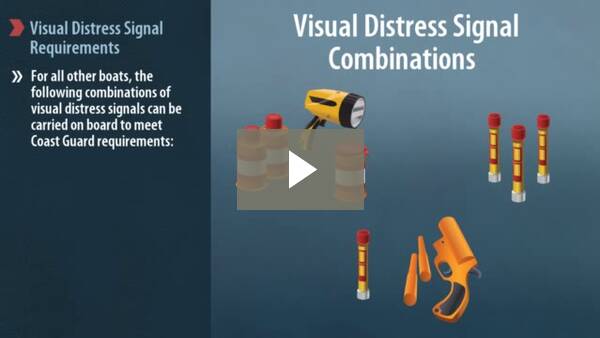Sound Signal Devices
Sound signals are used to attract the attention of other boaters and to aid with navigation. A sound signalling device can be a whistle, a bell, a horn or a gong. All of these devices must be capable of sounding a four second-long blast.
The bell or gong may be replaced by other sound equipment that has the same sound characteristics, such as a horn.
Additionally, you must know the difference between a ’short blast’ and a ‘prolonged blast’:
- A ‘short blast’ = a duration of one second.
- A ‘prolonged blast’ = a duration of four to six seconds.
Sound signals are also used to signal your distress to other boaters during an emergency. The ‘S.O.S.’ emergency sound signal is three prolonged whistle blasts—then three short blasts—then three prolonged blasts—then pause and repeat.
Sound Signal Device Requirements
If your boat is:
12 meters or less: You must carry at least one mechanical sound signaling device, like a whistle or a horn (personal watercraft are included in this category). The device used for boats of this size must be audible for a ½ mile.
12 meters or more: All boats of this size must carry a whistle or a horn and a bell. The required device for boats of this size must be audible for ½ mile.
Visual Distress Signals
You must be able to recognize when other boaters are in trouble. You are also responsible for knowing how to properly use visual distress signals if YOU are in trouble. Like your other boating equipment, your visual distress signal must be maintained, stowed in a readily accessible place and be Coast Guard-approved.
All boats operating on federal waters are required to carry visual distress signals onboard. Federal waters include: U.S. coastal waters, the Great Lakes and territorial seas and those waters connected directly to the Great Lakes or territorial seas, up to a point where the waters are less than two miles wide.
Additionally, boats owned in the United States and operating on the high seas must be equipped with visual distress signal devices.
Day Use Visual Distress Signals
Hand Signal:
By slowly waving your outstretched hands above your head, you will be signaling distress to others.
Code Flags:
Code flags can be used to signal distress. Use either of the following:
- The International Signal for Distress: Code Flag ‘N’ (November) flown above Code Flag ‘C’ (Charlie).
- An orange distress cloth (or flag), displaying a black square and a black circle, identifiable from the air.
Dye Marker:
- You can release a dye marker in the water around your boat to stain the water a bright orange or green color.
Orange Smoke Handheld or Floating Device:
- Once activated, this handheld or floating device will produce a bright orange smoke that will be visible during the daytime.
- Always raise the device above your head for your safety and for greater visibility—the orange smoke will be visible to other boaters and to those on shore.
Day and Night Use VDS (Pyrotechnic)
A pyrotechnic visual distress signal must be within the expiration date, it must be Coast Guard-approved and it must be easy to locate on your boat. Always remember to read and follow the manufacturer’s instructions for your pyrotechnic device.
Red Flare (Hand-Held):
- This pyrotechnic device will be visible both at night and during the day.
- Hold the flare above your head to release red smoke into the air above your boat.
Red Meteor/Parachute Flare:
- The Red Meteor and Parachute Flare are both launched using pistol launchers (they function like handguns).
- In some states, pistol launchers are considered to be firearms and are prohibited from use (check your state-specific regulations).
- Any launcher made before January 1st, 1981, and that is meant to be used with a Coast Guard- approved visual distress signal, does not require Coast Guard-approval.
Night-Only Use
Electric Distress Light:
- An Electric Distress Light automatically flashes the international distress signal (S.O.S).
- The distress light must be turned on manually and can only be used at night.
- The light must have a sticker on it that indicates it’s Coast Guard approval.
Safe Boating Tip:
In an emergency, you can create an S.O.S. signal using your flashlight. To do this, use three short flashes, then three long flashes, followed by three short flashes. The light pattern would look like this: (• • • – – – • • •).
Visual Distress Signal Requirements
Your boat’s carrying requirements for visual distress signals depend on the boat’s size and whether the boat is powered, sail-powered or human-powered.
The following boats do not require day signals but must carry night signals if they’re on the water between sunset and sunrise:
- Human-powered boats.
- Recreational boats less than 16 feet in length.
- Wind-powered sailboats that are less than 26 feet in length.
- Boats that are part of an organized event (like a race).
For all other boats, the following combinations of visual distress signals can be carried onboard to meet Coast Guard requirements:
Option 1: Three Handheld Red Flares (day and night).
Option 2: One Handheld Red Flare and two Red Meteors (day and night).
Option 3: One Handheld Orange Smoke Signal (day), two Floating Orange Smoke Signals (day) and one Electric Distress Light (night only).
Note: It’s illegal to make or to report a fake distress signal. Sending out a ‘false alarm’ could make a response team unavailable during a real emergency.











